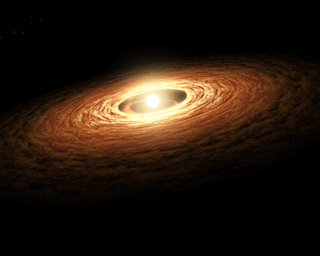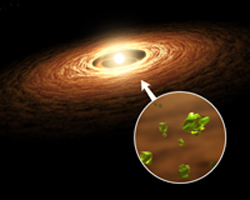
|
Silicate Crystal Formation in the Disk of an Erupting Star (Artist Concept)
- Click the image above for a larger view
 Movie Download Options
Movie Download Options- Full-Res JPEG (3000 x 2400) (276.9 kB)
- Full-Res TIFF (3000 x 2400) (21.6 MB)
Caption:
|
This artist's concept illustrates how silicate crystals like those found in comets can be created by an outburst from a growing star. The image shows a young sun-like star encircled by its planet-forming disk of gas and dust. The silicate that makes up most of the dust would have begun as non-crystallized, amorphous particles.
Streams of material are seen spiraling from the disk onto the star increasing its mass and causing the star to brighten and heat up dramatically. The outburst causes temperatures to rise in the star's surrounding disk.
The animation (figure 1) zooms into the disk to show close-ups of silicate particles. When the disk warms from the star's outburst, the amorphous particles of silicate melt. As they cool off, they transform into forsterite (figure 2), a type of silicate crystal often found in comets in our solar system.
In April 2008, NASA's Spitzer Space Telescope detected evidence of this process taking place on the disk of a young sun-like star called EX Lupi.
Cataloging Keywords:
| Name | Value | Additional Values |
|---|---|---|
| Target | EX Lupi | |
| System | EX Lupi | |
| Target Type | Exoplanet | |
| Mission | Spitzer Space Telescope | |
| Instrument Host | Spitzer Space Telescope | |
| Host Type | Space Telescope | |
| Instrument | ||
| Detector | ||
| Extra Keywords | Artwork, Color, Disk, Dust, Infrared, Movie | |
| Acquisition Date | ||
| Release Date | 2009-05-13 | |
| Date in Caption | ||
| Image Credit | NASA/JPL-Caltech | |
| Source | photojournal.jpl.nasa.gov/catalog/PIA12008 | |
| Identifier | PIA12008 | |


